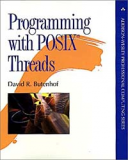Книга: Programming with POSIX® Threads
10.2.3 Spinlocks
10.2.3 Spinlocks
Spinlocks are much like mutexes. There's been a lot of discussion about whether it even makes sense to standardize on a spinlock interface — since POSIX specifies only a source level API, there's very little POSIX.1j says about them that distinguishes them from mutexes. The essential idea is that a spinlock is the most primitive and fastest synchronization mechanism available on a given hardware architecture. On some systems, that may be a single "test and set" instruction — on others, it may be a substantial sequence of "load locked, test, store conditional, memory barrier" instructions.
The critical distinction is that a thread trying to lock a spinlock does not necessarily block when the spinlock is already held by another thread. The intent is that the thread will "spin," retrying the lock rapidly until it succeeds in locking the spinlock. (This is one of the "iffy" spots — on a uniprocessor it had better block, or it'll do nothing but spin out the rest of its timeslice . . . or spin to eternity if it isn't timesliced.)
Spinlocks are great for fine-grained parallelism, when the code is intended to run only on a multiprocessor, carefully tuned to hold the spinlock for only a few instructions, and getting ultimate performance is more important than sharing the system resources cordially with other processes. To be effective, a spinlock must never be locked for as long as it takes to "context switch" from one thread to another. If it does take as long or longer, you'll get better overall performance by blocking and allowing some other thread to do useful work.
POSIX.1j contains two sets of spinlock functions: one set with a spin_ prefix, which allows spinlock synchronization between processes; and the other set with a pthread_ prefix, allowing spinlock synchronization between threads within a process. This, you will notice, is very different from the model used for mutexes, condition variables, and read/write locks, where the same functions were used and the pshared attribute specifies whether the resulting synchronization object can be shared between processes.
The rationale for this is that spinlocks are intended to be very fast, and should not be subject to any possible overhead as a result of needing to decide, at run time, how to behave. It is, in fact, unlikely that the implementation of spin_lock and pthread_spin_lock will differ on most systems, but the standard allows them to be different.




